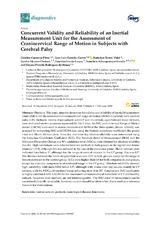Mostrar el registro sencillo del ítem
Concurrent Validity and Reliability of an Inertial Measurement Unit for the Assessment of Craniocervical Range of Motion in Subjects with Cerebral Palsy
| dc.contributor.author | Carmona-Pérez, Cristina | |
| dc.contributor.author | Garrido Castro, Juan Luis | |
| dc.contributor.author | Torres Vidal, Francisco | |
| dc.contributor.author | Alcaraz-Clariana, Sandra | |
| dc.contributor.author | García-Luque, Lourdes | |
| dc.contributor.author | Alburquerque Sendín, Francisco | |
| dc.contributor.author | Rodrigues-de-Souza, Daiana Priscila | |
| dc.date.accessioned | 2020-02-03T08:34:41Z | |
| dc.date.available | 2020-02-03T08:34:41Z | |
| dc.date.issued | 2020 | |
| dc.identifier.uri | http://hdl.handle.net/10396/19447 | |
| dc.description.abstract | Objective: This study aimed to determine the validity and reliability of Inertial Measurement Units (IMUs) for the assessment of craniocervical range of motion (ROM) in patients with cerebral palsy (CP). Methods: twenty-three subjects with CP and 23 controls, aged between 4 and 14 years, were evaluated on two occasions, separated by 3 to 5 days. An IMU and a Cervical Range of Motion device (CROM) were used to assess craniocervical ROM in the three spatial planes. Validity was assessed by comparing IMU and CROM data using the Pearson correlation coefficient, the paired t-test and Bland–Altman plots. Intra-day and inter-day relative reliability were determined using the Intraclass Correlation Coefficient (ICC). The Standard Error of Measurement (SEM) and the Minimum Detectable Change at a 90% confidence level (MDC90) were obtained for absolute reliability. Results: High correlations were detected between methods in both groups on the sagittal and frontal planes (r > 0.9), although this was reduced in the case of the transverse plane. Bland–Altman plots indicated bias below 5º, although for the range of cervical rotation in the CP group, this was 8.2º. The distance between the limits of agreement was over 23.5º in both groups, except for the range of flexion-extension in the control group. ICCs were higher than 0.8 for both comparisons and groups, except for inter-day comparisons of rotational range in the CP group. Absolute reliability showed high variability, with most SEM below 8.5º, although with worse inter-day results, mainly in CP subjects, with the MDC90 of rotational range achieving more than 20º. Conclusions: IMU application is highly correlated with CROM for the assessment of craniocervical movement in CP and healthy subjects; however, both methods are not interchangeable. The IMU error of measurement can be considered clinically acceptable; however, caution should be taken when this is used as a reference measure for interventions. | es_ES |
| dc.format.mimetype | application/pdf | es_ES |
| dc.language.iso | eng | es_ES |
| dc.publisher | MDPI | es_ES |
| dc.rights | https://creativecommons.org/licenses/by/4.0/ | es_ES |
| dc.source | Diagnostics 10(2), 80 (2020) | es_ES |
| dc.subject | Inertial sensors | es_ES |
| dc.subject | Pediatric neurological disease | es_ES |
| dc.subject | Kinematics | es_ES |
| dc.title | Concurrent Validity and Reliability of an Inertial Measurement Unit for the Assessment of Craniocervical Range of Motion in Subjects with Cerebral Palsy | es_ES |
| dc.type | info:eu-repo/semantics/article | es_ES |
| dc.relation.publisherversion | http://dx.doi.org/10.3390/diagnostics10020080 | es_ES |
| dc.relation.projectID | Junta de Andalucía. PI-0324-2017 | es_ES |
| dc.relation.projectID | Junta de Andalucía. PIN-0079-2016 | es_ES |
| dc.rights.accessRights | info:eu-repo/semantics/openAccess | es_ES |

